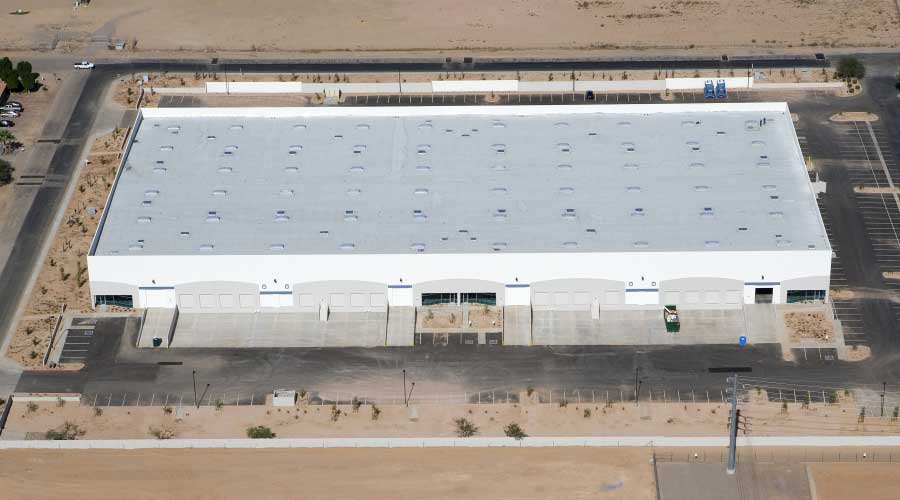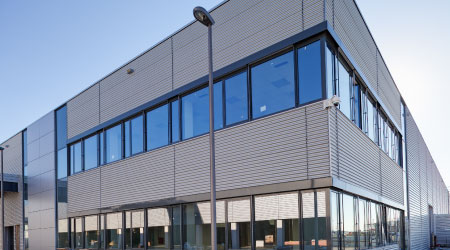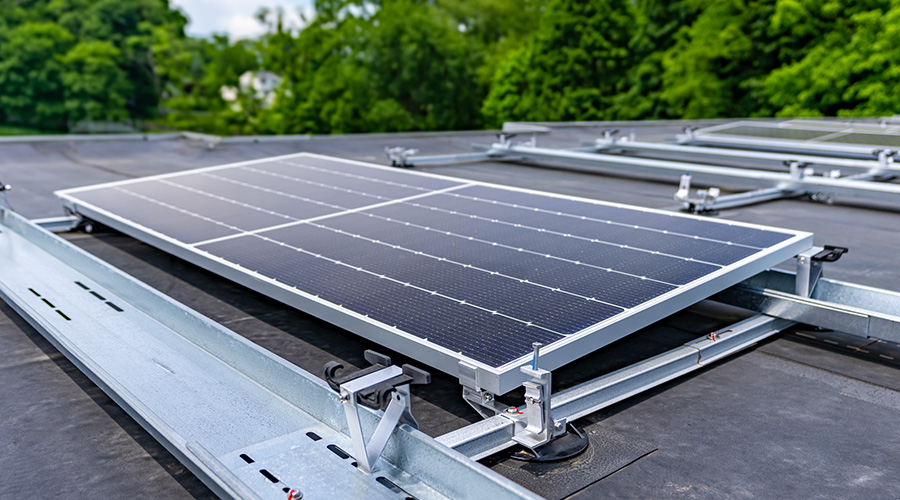Pinpointing Roofing Problems
Focusing time and attention on areas such as perimeters, penetrations and seams can pay long-term dividends
The life of any roofing system is finite. Most low-slope roofing materials begin to exhibit water infiltration within 20 years after installation. Distress conditions and leaks on low-slope roofs are more likely to emerge at certain predictable areas, such as at punctures or seams in single-ply membranes.
Leaks also often occur where pipes or vents penetrate the roof membrane, as well as at roof perimeters where roofing systems transition to other materials. By identifying areas that are prone to developing problems, maintenance and engineering managers can take steps that will prevent roof problems cost effectively.
Penetrations
Flashings and sealants at penetrations through the roof membrane are common trouble spots. Technicians should conduct regular inspections, roof surveys and preventive maintenance steps to detect and prevent leaks in these areas.
Typically in single-ply roofing systems, penetration flashings are the same material as the roof membrane and are bonded to the field membrane. Maintenance technicians should inspect the laps, seams and sealants at these locations regularly.
Factory-assembled boots can address field installation issues at penetrations. It is important that technicians properly seal the boot to the field membrane, where problems typically occur.
Roof drains that penetrate a roof membrane can be especially troublesome because rain that falls onto the roof eventually flows over the drain's seal. Drains should be large enough to handle heavy rainfalls, and they should have a screen that stops debris from flowing down the pipe.
Workers should clean the drain regularly to prevent blockage of the screen and install recessed drain sumps. A positive slope in the roof also can prevent ponding around drains.
Irregularly shaped penetrations or multiple penetrations in one location also can cause problems. Traditionally, workers use a pitch pan to prevent problems at these trouble spots. Unfortunately, the flexible material used to fill the pan reacts differently in hot and cold climates and during daily and seasonal temperature swings. Many materials shrink or deteriorate over time, requiring workers to refill the pans.
A better solution in these difficult areas is to install a box with a sheet-metal hood that covers the penetrations.
The best way to avoid leaks at roof penetrations is to avoid penetrations altogether. For instance, ducts, conduits and other piping that runs horizontally across the roof often are placed on solid supports that are anchored to and penetrate the roof membrane at regular intervals.
To avoid these penetrations, managers can specify products with adjustable heights and soft feet that rest on the membrane. If a horizontal element must be anchored to the roof, build a curb and secure the element supports to the curb.
Perimeters
Leaks occur near roof edges because of the transition from flexible membrane flashings to inflexible sheet-metal flashings. Technicians should ensure that sheet-metal laps shed water, and they should inspect the sealants at these locations regularly.
Pre-manufactured sheet-metal roof accessories can solve many roof-perimeter problems. Managers can specify custom-made accessories for copings at parapet walls and reglets at masonry or interior rising walls. These components typically snap together, and technicians can dismantle and re-install them during roof-membrane replacements.
Water problems also occur near expansion joints at roof perimeters. To address areas where building expansions and contractions are likely to occur, managers might want to to consider specifying pre-manufactured roof accessories. But managers need to make sure accessories they specify are compatible with the roof membrane.
Seams and Fasteners
All roofs must address the potential for wind uplift. Buildings in a high-wind zones or close to open water must comply with more stringent building codes and local regulations. Managers have three options to address wind uplift concerns - place ballast on the roof membrane, fully apply an adhesive under the roof membrane, or use mechanical fasteners, such as screws and plates. System specific issues include these:
Ballasted roofing systems. In a ballasted roof system, the widths of membrane sheets can be up to 40 feet wide, thereby reducing the number of seams required. These systems, which could feature concrete pavers or 4 inches of heavy gravel for the ballast, demand a roof structure that can support the extra weight.
Fully adhered roofing systems. A fully adhered system uses hot asphalt or adhesives to bond the membrane to the insulation or deck surface. These systems can be expensive and might not be appropriate for some types of structures. For single-ply roofing systems, fully adhered systems use smaller roll widths than ballasted systems and, therefore, have more seams. For modified bitumen or built-up roofing systems, there has been a recent shift to fully adhered granular-surfaced cap sheets. This has occurred primarily because of dangers associated with hot-asphalt and torch-applied systems. Managers can avoid these dangers by specifying modified bitumen sheets with self-adhesive backings.
Mechanically attached systems. Because of wind-uplift requirements, the roll widths of single-ply roof membranes in mechanically attached systems should not exceed 72 inches. This standard means that the linear footage of seams on mechanically attached single-ply roof systems is very high. Because of the nature of single-ply roofing and the monolithic nature of low-slope roofs, these seams must be perfect.
Seaming technology on single-ply roofs has improved greatly in the past 10 years. In the past, seam failures were common on thermoset roofing systems, such as ethylene propylene diene terpolymer. Tech-nological advances in adhesive formulations, seam tapes and self-adhesive seams have greatly improved seam strengths and reduced failures.
Double-weld seams are required on most single-ply mechanically attached systems. This requirement might imply that the customer is getting a redundant seal, but the requirement is primarily for wind uplift on mechanically fastened systems where the membrane laps are sealed on either side of the fastener bar inside the lap seam. Regardless of the type of roof membrane, scheduling routine seam inspections is a good idea.
Condensation
Sometimes, a roof might appear to leak in January when the temperature dips below freezing, but the roof might not be leaking. Instead, condensation created when the warm, moist interior air inside the building contacts cold surfaces or when cold air leaks through the building's exterior skin.
This problem might result from a missing or inadequate air barrier or vapor retarder on ceilings or walls, or from inadequate insulation or ventilation.
Cold areas above the insulation in joist cavities or attic spaces must be vented. If natural ventilation is difficult or too expensive, technicians can install a fan that moves moist air out of the cold space.
Roof leaks that are ignored for too long can cause corrosion and wood decay, damage insulation and be costly to fix. Manufacturers are constantly introducing new technology for leak detection and remediation. To diagnose and fix roofing problems as cost effectively as possible, it is critical that managers keep up with these developments.
Wade L. Vorley, CDT, Associate AIA, is an associate at Wiss, Janney, Elstner Associates (WJE) in Seattle and has provided roof consulting services in California and the Pacific Northwest for more than 20 years. David A. Deress, P.E., R.A., has been a consultant at WJE in Seattle since 1986. He has conducted numerous assessments and diagnoses of water-leakage problems in the West and Midwest for the past 20 years.
Leak-Detection Technology: A New Generation
During the past 30 years, manufacturers have introduced several non-destructive technologies for finding roof leaks. They include:
Electric capacitance meters. These are the most common and affordable leak-detection systems. Users identify leaks using a meter that transmits low-frequency signals through the roof's surface. The signals return when the meter detects moisture below the roof surface.
Technicians can use these meters to scan a specific area of a roof or to conduct a full survey of large areas as a preventive measure. When technicians suspect moisture below the roof surface, they can cut open the roof to confirm the findings.
Infrared cameras. Infrared (IR) cameras with digital photographic capabilities have become much more affordable and popular in recent years. These hand-held cameras allow technicians to scan roof surfaces, but only experienced users should interpret the scans these cameras produce. IR cameras measure temperature differentials and display the information in a color-coded, graphic format.
IR cameras have limits, however. Shadows, under-roof heat sources, and air conditioning can produce skewed results. The settings for exposed single-ply roofing systems and ballasted systems can require careful adjustments. Technicians also should consider the time of day, the time of year and the dryness of the roof surface during an IR scan. Nonetheless, IR cameras are extremely valuable leak-detection tools if users properly interpret the information.
Electric field vector mapping. One of the newest technologies for leak detection, electric field vector mapping (EFVM) technology, uses a wire loop around the perimeter of the roof surface and introduces an electric potential. The structural deck below becomes the lower electrical plate, allowing users to identify and locate leaks as small as a pinhole.
This technology is excellent for detecting problems on roofs with membranes that are not directly visible, such as ballasted systems, plazas and green roofs. Technicians can build the wire loop and connections into the system for inexpensive regular inspections or construct them to locate problem areas when leaks occur.
- Wade L. Vorley and David A. Deress
|
Related Topics:











